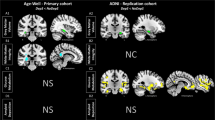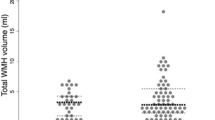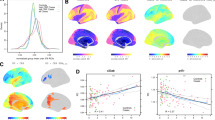Abstract
Peripheral inflammation has been implicated in cognitive dysfunction and dementia. While studies outline the relationship between elevated inflammation and individual gray or white matter alterations, less work has examined inflammation as related to connectivity between gray and white matter or variability in these associations by race. We examined the relationship between peripheral inflammation and tract-based structural connectomics in 74 non-demented participants (age = 69.19 ± 6.80 years; 53% female; 45% Black) who underwent fasting venipuncture and MRI. Serum was assayed for C-reactive protein, interleukin-6, and interleukin-1β. Graph theory analysis integrated T1-derived gray matter volumes and DTI-derived white matter tractography into connectivity matrices analyzed for local measures of nodal strength and efficiency in a priori regions of interest associated with cardiovascular disease risk factors and dementia. Linear regressions adjusting for relevant covariates showed associations between inflammatory markers and nodal strength in the isthmus, posterior and caudal anterior cingulate (p’s ≤ .042). Adding an inflammatory marker*race term showed race-modified associations between C-reactive protein and efficiency in the thalamus and amygdala, and nodal strength in the putamen (p’s ≤ .048), between interleukin-6 and efficiency in the pars triangularis and amygdala (p’s ≤ .024), and between interleukin-1β and nodal strength in the pars opercularis (p = .048). Higher levels of inflammation associated with lower efficiency and higher strength for White participants but higher efficiency and lower strength for Black participants. Results suggest inflammation is associated with tract-based structural connectomics in an older diverse cohort and that differential relationships may exist by race within prefrontal and limbic brain regions.

Similar content being viewed by others
Availability of data and material
Research data is confidential given that we do not have participant approval to share data with outside investigators.
Code availability
Available upon request.
References
Andersson, J. L. R., & Sotiropoulos, S. N. (2016). An integrated approach to correction for off-resonance effects and subject movement in diffusion MR imaging. Neuroimage, 125, 1063–1078. https://doi.org/10.1016/j.neuroimage.2015.10.019.
Avants, B. B., Tustison, N. J., Stauffer, M., Song, G., Wu, B., & Gee, J. C. (2014). The insight ToolKit image registration framework. Frontiers in Neuroinformatics, 8, 44. https://doi.org/10.3389/fninf.2014.00044.
Bagby, S. P., Martin, D., Chung, S. T., & Rajapakse, N. (2019). From the outside in: Biological mechanisms linking social and environmental exposures to chronic Disease and to Health disparities. American Journal of Public Health, 109(S1), S56–S63. https://doi.org/10.2105/AJPH.2018.304864.
Barulli, D., & Stern, Y. (2013). Efficiency, capacity, compensation, maintenance, plasticity: Emerging concepts in cognitive reserve. Trends in Cognitive Sciences, 17(10), 502–509. https://doi.org/10.1016/j.tics.2013.08.012.
Behrens, T. E., Berg, H. J., Jbabdi, S., Rushworth, M. F., & Woolrich, M. W. (2007). Probabilistic diffusion tractography with multiple fibre orientations: What can we gain? Neuroimage, 34(1), 144–155. https://doi.org/10.1016/j.neuroimage.2006.09.018.
Bettcher, B. M., Wilheim, R., Rigby, T., Green, R., Miller, J. W., Racine, C. A., Yaffe, K., Miller, B. L., & Kramer, J. H. (2012). C-reactive protein is related to memory and medial temporal brain volume in older adults. Brain, Behavior, and Immunity, 26(1), 103–108. https://doi.org/10.1016/j.bbi.2011.07.240.
Bettcher, B. M., Yaffe, K., Boudreau, R. M., Neuhaus, J., Aizenstein, H., Ding, J., et al. (2015). Declines in inflammation predict greater white matter microstructure in older adults. Neurobiology of Aging, 36(2), 948–954. https://doi.org/10.1016/j.neurobiolaging.2014.11.004.
Boots, E. A., Castellanos, K. J., Zhan, L., Barnes, L. L., Tussing-Humphreys, L., Deoni, S. C. L., & Lamar, M. (2020). Inflammation, cognition, and white matter in older adults: An examination by race. Frontiers in Aging Neuroscience, 12, 553998. https://doi.org/10.3389/fnagi.2020.553998.
Boots, E. A., Zhan, L., Dion, C., Karstens, A. J., Peven, J. C., Ajilore, O., & Lamar, M. (2019). Cardiovascular disease risk factors, tract-based structural connectomics, and cognition in older adults. Neuroimage, 196, 152–160. https://doi.org/10.1016/j.neuroimage.2019.04.024.
Braak, H., & Braak, E. (1991). Neuropathological stageing of Alzheimer-related changes. Acta Neuropathologica, 82(4), 239–259. https://doi.org/10.1007/BF00308809.
Bronas, U. G., Steffen, A., Dion, C., Boots, E. A., Arfanakis, K., Marquez, D. X., & Lamar, M. (2019). Sedentary time and white matter Hyperintensity volume in older adults. Medicine and Science in Sports and Exercise, 51, 1613–1618. https://doi.org/10.1249/MSS.0000000000001957.
Dale, A. M., Fischl, B., & Sereno, M. I. (1999). Cortical surface-based analysis. I. Segmentation and surface reconstruction. Neuroimage, 9(2), 179–194. https://doi.org/10.1006/nimg.1998.0395.
Destrieux, C., Fischl, B., Dale, A., & Halgren, E. (2010). Automatic parcellation of human cortical gyri and sulci using standard anatomical nomenclature. Neuroimage, 53(1), 1–15. https://doi.org/10.1016/j.neuroimage.2010.06.010.
Dickerson, B. C., Bakkour, A., Salat, D. H., Feczko, E., Pacheco, J., Greve, D. N., Grodstein, F., Wright, C. I., Blacker, D., Rosas, H. D., Sperling, R. A., Atri, A., Growdon, J. H., Hyman, B. T., Morris, J. C., Fischl, B., & Buckner, R. L. (2009). The cortical signature of Alzheimer's disease: Regionally specific cortical thinning relates to symptom severity in very mild to mild AD dementia and is detectable in asymptomatic amyloid-positive individuals. Cerebral Cortex, 19(3), 497–510. https://doi.org/10.1093/cercor/bhn113.
Engelhart, M. J., Geerlings, M. I., Meijer, J., Kiliaan, A., Ruitenberg, A., van Swieten, J. C., Stijnen, T., Hofman, A., Witteman, J. C. M., & Breteler, M. M. (2004). Inflammatory proteins in plasma and the risk of dementia: The Rotterdam study. Archives of Neurology, 61(5), 668–672. https://doi.org/10.1001/archneur.61.5.668.
Felger, J. C., & Miller, A. H. (2012). Cytokine effects on the basal ganglia and dopamine function: The subcortical source of inflammatory malaise. Frontiers in Neuroendocrinology, 33(3), 315–327. https://doi.org/10.1016/j.yfrne.2012.09.003.
Glymour, M. M., & Manly, J. J. (2008). Lifecourse social conditions and racial and ethnic patterns of cognitive aging. Neuropsychology Review, 18(3), 223–254. https://doi.org/10.1007/s11065-008-9064-z.
Goldstein, F. C., Zhao, L., Steenland, K., & Levey, A. I. (2015). Inflammation and cognitive functioning in African Americans and Caucasians. International Journal of Geriatric Psychiatry, 30(9), 934–941. https://doi.org/10.1002/gps.4238.
Golia, E., Limongelli, G., Natale, F., Fimiani, F., Maddaloni, V., Pariggiano, I., et al. (2014). Inflammation and cardiovascular disease: From pathogenesis to therapeutic target. Current Atherosclerosis Reports, 16(9), 435. https://doi.org/10.1007/s11883-014-0435-z.
Gu, Y., Vorburger, R., Scarmeas, N., Luchsinger, J. A., Manly, J. J., Schupf, N., Mayeux, R., & Brickman, A. M. (2017). Circulating inflammatory biomarkers in relation to brain structural measurements in a non-demented elderly population. Brain, Behavior, and Immunity, 65, 150–160. https://doi.org/10.1016/j.bbi.2017.04.022.
Heneka, M. T., Carson, M. J., El Khoury, J., Landreth, G. E., Brosseron, F., Feinstein, D. L., et al. (2015). Neuroinflammation in Alzheimer's disease. Lancet Neurology, 14(4), 388–405. https://doi.org/10.1016/S1474-4422(15)70016-5.
Hilal, S., Ikram, M. A., Verbeek, M. M., Franco, O. H., Stoops, E., Vanderstichele, H., Niessen, W. J., & Vernooij, M. W. (2018). C-reactive protein, plasma amyloid-beta levels, and their interaction with magnetic resonance imaging markers. Stroke, 49(11), 2692–2698. https://doi.org/10.1161/STROKEAHA.118.022317.
Hill, C. V., Perez-Stable, E. J., Anderson, N. A., & Bernard, M. A. (2015). The National Institute on Aging Health disparities research framework. Ethn Dis, 25(3), 245–254. https://doi.org/10.18865/ed.25.3.245.
Holmes, C. (2013). Review: Systemic inflammation and Alzheimer's disease. Neuropathology and Applied Neurobiology, 39(1), 51–68. https://doi.org/10.1111/j.1365-2990.2012.01307.x.
Howard, G., Safford, M. M., Moy, C. S., Howard, V. J., Kleindorfer, D. O., Unverzagt, F. W., Soliman, E. Z., Flaherty, M. L., McClure, L. A., Lackland, D. T., Wadley, V. G., Pulley, L. V., & Cushman, M. (2017). Racial differences in the incidence of cardiovascular risk factors in older black and white adults. Journal of the American Geriatrics Society, 65(1), 83–90. https://doi.org/10.1111/jgs.14472.
Janowitz, D., Habes, M., Toledo, J. B., Hannemann, A., Frenzel, S., Terock, J., Davatzikos, C., Hoffmann, W., & Grabe, H. J. (2019). Inflammatory markers and imaging patterns of advanced brain aging in the general population. Brain Imaging and Behavior, 14, 1108–1117. https://doi.org/10.1007/s11682-019-00058-y.
Jefferson, A. L., Beiser, A. S., Himali, J. J., Seshadri, S., O'Donnell, C. J., Manning, W. J., et al. (2015). Low cardiac index is associated with incident dementia and Alzheimer disease: The Framingham heart study. Circulation, 131(15), 1333–1339. https://doi.org/10.1161/CIRCULATIONAHA.114.012438.
Kaplan, J. B., & Bennett, T. (2003). Use of race and ethnicity in biomedical publication. JAMA, 289(20), 2709–2716. https://doi.org/10.1001/jama.289.20.2709.
Kempuraj, D., Thangavel, R., Selvakumar, G. P., Zaheer, S., Ahmed, M. E., Raikwar, S. P., Zahoor, H., Saeed, D., Natteru, P. A., Iyer, S., & Zaheer, A. (2017). Brain and peripheral atypical inflammatory mediators potentiate Neuroinflammation and neurodegeneration. Frontiers in Cellular Neuroscience, 11, 216. https://doi.org/10.3389/fncel.2017.00216.
Kim, Y. K., & Won, E. (2017). The influence of stress on neuroinflammation and alterations in brain structure and function in major depressive disorder. Behavioural Brain Research, 329, 6–11. https://doi.org/10.1016/j.bbr.2017.04.020.
Lamar, M., Boots, E. A., Arfanakis, K., Barnes, L. L., & Schneider, J. A. (2020a). Advances in multi-modal imaging across the Spectrum of Normal to pathological aging: Incorporating vascular comorbidities common to Alzheimer's Disease and vascular dementia. In D. J. Libon, M. Lamar, R. A. Swenson, & K. M. Heilman (Eds.), Vascular Disease, Alzheimer's Disease, and mild cognitive impairment : Advancing an integrated approach (pp. 241–258). Oxford University Press.
Lamar, M., Boots, E. A., Arfanakis, K., Barnes, L. L., & Schneider, J. A. (2020b). Common brain structural alterations associated with cardiovascular Disease risk factors and Alzheimer's Dementia: Future Directions and Implications. Neuropsychol Rev. https://doi.org/10.1007/s11065-020-09460-6.
Liu, G., Allen, B., Lopez, O., Aizenstein, H., Boudreau, R., Newman, A., Yaffe, K., Kritchevsky, S., Launer, L., Satterfield, S., Simonsick, E., & Rosano, C. (2015). Racial differences in gray matter integrity by diffusion tensor in black and white octogenarians. Current Alzheimer Research, 12(7), 648–654. https://doi.org/10.2174/1567205011666141107153634.
Manly, J. J., Jacobs, D. M., Touradji, P., Small, S. A., & Stern, Y. (2002). Reading level attenuates differences in neuropsychological test performance between African American and white elders. Journal of the International Neuropsychological Society, 8(3), 341–348. https://doi.org/10.1017/s1355617702813157.
Marsland, A. L., Gianaros, P. J., Abramowitch, S. M., Manuck, S. B., & Hariri, A. R. (2008). Interleukin-6 covaries inversely with hippocampal grey matter volume in middle-aged adults. Biological Psychiatry, 64(6), 484–490. https://doi.org/10.1016/j.biopsych.2008.04.016.
Marsland, A. L., Gianaros, P. J., Kuan, D. C., Sheu, L. K., Krajina, K., & Manuck, S. B. (2015). Brain morphology links systemic inflammation to cognitive function in midlife adults. Brain, Behavior, and Immunity, 48, 195–204. https://doi.org/10.1016/j.bbi.2015.03.015.
Michaud, M., Balardy, L., Moulis, G., Gaudin, C., Peyrot, C., Vellas, B., Cesari, M., & Nourhashemi, F. (2013). Proinflammatory cytokines, aging, and age-related diseases. Journal of the American Medical Directors Association, 14(12), 877–882. https://doi.org/10.1016/j.jamda.2013.05.009.
Miller, A. H., Haroon, E., Raison, C. L., & Felger, J. C. (2013). Cytokine targets in the brain: Impact on neurotransmitters and neurocircuits. Depression and Anxiety, 30(4), 297–306. https://doi.org/10.1002/da.22084.
Miralbell, J., Soriano, J. J., Spulber, G., Lopez-Cancio, E., Arenillas, J. F., Bargallo, N., . . . Mataro, M. (2012). Structural brain changes and cognition in relation to markers of vascular dysfunction. Neurobiol Aging, 33(5), 1003 e1009-1017. https://doi.org/10.1016/j.neurobiolaging.2011.09.020.
Morgan, A., & Ziglio, E. (2007). Revitalising the evidence base for public health: An assets model. Promot Educ, Suppl, 2, 17–22. https://doi.org/10.1177/10253823070140020701x.
Nazmi, A., & Victora, C. G. (2007). Socioeconomic and racial/ethnic differentials of C-reactive protein levels: A systematic review of population-based studies. BMC Public Health, 7, 212. https://doi.org/10.1186/1471-2458-7-212.
Nyquist, P. A., Bilgel, M. S., Gottesman, R., Yanek, L. R., Moy, T. F., Becker, L. C., Cuzzocreo, J., Prince, J., Yousem, D. M., Becker, D. M., Kral, B. G., & Vaidya, D. (2014). Extreme deep white matter hyperintensity volumes are associated with African American race. Cerebrovascular Diseases, 37(4), 244–250. https://doi.org/10.1159/000358117.
Rubinov, M., & Sporns, O. (2010). Complex network measures of brain connectivity: Uses and interpretations. Neuroimage, 52(3), 1059–1069. https://doi.org/10.1016/j.neuroimage.2009.10.003.
Schmidt, M. F., Freeman, K. B., Windham, B. G., Griswold, M. E., Kullo, I. J., Turner, S. T., & Mosley Jr., T. H. (2016). Associations between serum inflammatory markers and hippocampal volume in a community sample. Journal of the American Geriatrics Society, 64(9), 1823–1829. https://doi.org/10.1111/jgs.14283.
Singh, T., & Newman, A. B. (2011). Inflammatory markers in population studies of aging. Ageing Research Reviews, 10(3), 319–329. https://doi.org/10.1016/j.arr.2010.11.002.
Sisco, S., Gross, A. L., Shih, R. A., Sachs, B. C., Glymour, M. M., Bangen, K. J., Benitez, A., Skinner, J., Schneider, B. C., & Manly, J. J. (2015). The role of early-life educational quality and literacy in explaining racial disparities in cognition in late life. The Journals of Gerontology. Series B, Psychological Sciences and Social Sciences, 70(4), 557–567. https://doi.org/10.1093/geronb/gbt133.
Smith, S. M. (2002). Fast robust automated brain extraction. Human Brain Mapping, 17(3), 143–155. https://doi.org/10.1002/hbm.10062.
Smith, S. M., Jenkinson, M., Woolrich, M. W., Beckmann, C. F., Behrens, T. E., Johansen-Berg, H., et al. (2004). Advances in functional and structural MR image analysis and implementation as FSL. Neuroimage, 23(Suppl 1), S208–S219. https://doi.org/10.1016/j.neuroimage.2004.07.051.
Swardfager, W., Lanctot, K., Rothenburg, L., Wong, A., Cappell, J., & Herrmann, N. (2010). A meta-analysis of cytokines in Alzheimer's disease. Biological Psychiatry, 68(10), 930–941. https://doi.org/10.1016/j.biopsych.2010.06.012.
Tegeler, C., O'Sullivan, J. L., Bucholtz, N., Goldeck, D., Pawelec, G., Steinhagen-Thiessen, E., & Demuth, I. (2016). The inflammatory markers CRP, IL-6, and IL-10 are associated with cognitive function--data from the Berlin aging study II. Neurobiology of Aging, 38, 112–117. https://doi.org/10.1016/j.neurobiolaging.2015.10.039.
Teunissen, C. E., van Boxtel, M. P., Bosma, H., Bosmans, E., Delanghe, J., De Bruijn, C., . . . de Vente, J. (2003). Inflammation markers in relation to cognition in a healthy aging population. J Neuroimmunol, 134(1-2), 142-150. Retrieved from https://www.ncbi.nlm.nih.gov/pubmed/12507782.
Waldburger, J. M., & Firestein, G. S. (2010). Regulation of peripheral inflammation by the central nervous system. Current Rheumatology Reports, 12(5), 370–378. https://doi.org/10.1007/s11926-010-0124-z.
Walker, K. A., Power, M. C., Hoogeveen, R. C., Folsom, A. R., Ballantyne, C. M., Knopman, D. S., Windham, B. G., Selvin, E., Jack Jr., C. R., & Gottesman, R. F. (2017). Midlife systemic inflammation, late-life white matter integrity, and cerebral Small vessel Disease: The atherosclerosis risk in communities study. Stroke, 48(12), 3196–3202. https://doi.org/10.1161/STROKEAHA.117.018675.
Ward, J. B., Gartner, D. R., Keyes, K. M., Fliss, M. D., McClure, E. S., & Robinson, W. R. (2019). How do we assess a racial disparity in health? Distribution, interaction, and interpretation in epidemiological studies. Annals of Epidemiology, 29, 1–7. https://doi.org/10.1016/j.annepidem.2018.09.007.
Wersching, H., Duning, T., Lohmann, H., Mohammadi, S., Stehling, C., Fobker, M., Conty, M., Minnerup, J., Ringelstein, E. B., Berger, K., Deppe, M., & Knecht, S. (2010). Serum C-reactive protein is linked to cerebral microstructural integrity and cognitive function. Neurology, 74(13), 1022–1029. https://doi.org/10.1212/WNL.0b013e3181d7b45b.
Windham, B. G., Simpson, B. N., Lirette, S., Bridges, J., Bielak, L., Peyser, P. A., Kullo, I., Turner, S., Griswold, M. E., & Mosley, T. H. (2014). Associations between inflammation and cognitive function in African Americans and European Americans. Journal of the American Geriatrics Society, 62(12), 2303–2310. https://doi.org/10.1111/jgs.13165.
Zhan, L., Jahanshad, N., Jin, Y., Toga, A. W., McMahon, K. L., Zubicaray, G. I. d., ... Thompson, P. M. (2013, 7–11 April 2013). Brain network efficiency and topology depend on the fiber tracking method: 11 tractography algorithms compared in 536 subjects. Paper presented at the 2013 IEEE 10th International Symposium on Biomedical Imaging.
Zhan, L., Zhou, J., Wang, Y., Jin, Y., Jahanshad, N., Prasad, G., et al. (2015). Comparison of nine tractography algorithms for detecting abnormal structural brain networks in Alzheimer's disease. Frontiers in Aging Neuroscience, 7, 48. https://doi.org/10.3389/fnagi.2015.00048.
Zhang, H., Sachdev, P. S., Wen, W., Crawford, J. D., Brodaty, H., Baune, B. T., Kochan, N. A., Slavin, M. J., Reppermund, S., Kang, K., & Trollor, J. N. (2016). The relationship between inflammatory markers and voxel-based gray matter volumes in nondemented older adults. Neurobiology of Aging, 37, 138–146. https://doi.org/10.1016/j.neurobiolaging.2015.10.008.
Acknowledgements
The authors would like to thank the participants of this study and all prior research assistants for their help collecting data.
Funding
Research was supported by the National Institute on Aging at the National Institutes of Health (K01 AG040192, R21 AG048176). Ms. Boots was further supported by F31 AG064829; Dr. Barnes was further supported by R01 AG056405.
Author information
Authors and Affiliations
Contributions
Author contributions included conception and study design (EAB, ML), data collection or acquisition (EAB, KJC, LTH, ML), statistical analysis (EAB, LZ, and ML), interpretation of results (EAB, LZ, LLB, LTH, ML), drafting the manuscript work or revising it critically for important intellectual content (all authors), and approval of final version to be published and agreement to be accountable for the integrity and accuracy of all aspects of the work (all authors).
Corresponding author
Ethics declarations
The study was approved by the University of Illinois at Chicago Institutional Review Board (IRB) in accordance with the Declaration of Helsinki with written informed consent for participation and publication obtained from all participants; it was also approved by the Rush University Medical Center IRB with data use agreements in place prior to analysis.
Conflict of interest
None of the authors have a conflict of interest to declare.
Additional information
Publisher’s note
Springer Nature remains neutral with regard to jurisdictional claims in published maps and institutional affiliations.
Supplementary Information
ESM 1
(DOCX 48 kb)
Rights and permissions
About this article
Cite this article
Boots, E.A., Zhan, L., Castellanos, K.J. et al. Inflammatory markers and tract-based structural connectomics in older adults with a preliminary exploration of associations by race. Brain Imaging and Behavior 16, 130–140 (2022). https://doi.org/10.1007/s11682-021-00483-y
Accepted:
Published:
Issue Date:
DOI: https://doi.org/10.1007/s11682-021-00483-y




